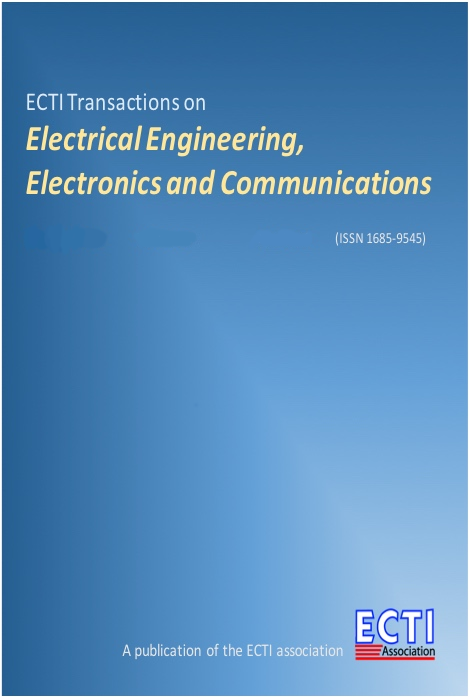Detection of Anxiety Expression From EEG Analysis Using Support Vector Machine
Main Article Content
Abstract
Support Vector Machine (SVMs) have been extensively researched in data mining and machine learning communities for the last decade and actively applied to application in various domains. SVMs are typically used for learning classification, regression and ranking function. Two specials properties of SVMs are that SVMs achieve high generalization by maximizing the margin and support an efficient learning of nonlinear functions by kernel trick. In this paper, we present how to clarify when we feel anxiety by using SVM technique to estimate the condition of user.
Article Details

This work is licensed under a Creative Commons Attribution-NonCommercial-NoDerivatives 4.0 International License.
This journal provides immediate open access to its content on the principle that making research freely available to the public supports a greater global exchange of knowledge.
- Creative Commons Copyright License
The journal allows readers to download and share all published articles as long as they properly cite such articles; however, they cannot change them or use them commercially. This is classified as CC BY-NC-ND for the creative commons license.
- Retention of Copyright and Publishing Rights
The journal allows the authors of the published articles to hold copyrights and publishing rights without restrictions.
References
[2] Toyota Central R&D Labs, Inc. Genesis Research Institute, Inc. "Real-time Control of Wheelchairs with Brain Waves." Detection of Anxiety Expression From EEG Analysis Using Support Vector Machine 93 RIKEN. Toyota Motor Corporation, Internet: https://www.riken.go.?jp/engn/r-world/info?/release/press/2009/?090629/index.html, June 29, 2009
[3] K. Yamada, N. Matsushima, Y. Sakashita, T. Yada, S. Hosoi, K. Shirakura and N. Hisata, "A study on the anxiety at utilization of wheelchair," Transactions of the Japan Society of Mechanical Engineers, C70-693, (2004), pp.1332-1340 (in Japanese)
[4] K. Yamada, K. Kotaki, N. Nakazawa, Y. Sakashita, Y. Kodera, S. Hosoi, K. Shirakura and N. Hisata," Estimation of a Declivity Angle for Human to feel the anxiety in the Case of Going Down Slopes using Wheelchair," Transactions of the Japan Society of Mechanical Engineers, C73-725, (2007), pp.145-153 (in Japanese)
[5] K. Yamada, Y. Kodera, N. Nakazawa, S. Hosoi, K. Shirakura and N. Hisata, "A study on anxiety at utilization of wheelchair : In the case of crossing the slope using wheelchair," Transactions of
the Japan Society of Mechanical Engineers, C71-707,(2005), pp.235-243 (in japanese)
[6] K. Yamada, Y. Zhao, S. Shiomi, T. Suzuki, D. T. Nguyen, T. Noguchi," Estimation of anxiety at utilizing wheelchair by measuring brain waves in the case of going down slopes using wheelchair," Electrical Engineering/Electronics, Computer, Telecommunication and Information Technology(ECTI-CON), Thailand, (2016,July)
[7] Bernahard Scholkopf,Alexander J.Smola, Library of Congress Cataloging-in-Publication Data;Learning with kernel-support vector machines,regulation,optimazation and beyond, The MIT Pres Cambridge, massachusetts London, England, 2002
[8] Nello Cristianini and John Shawe-Taylor, An introduction to Support vector Machines and others kernel-based learning methods, Cambrigde university press, 2000
[9] Boser B. Guyon , and I Vapnik V. A training algorithm for optimal margin classifiers. Fifth Annual Workshop on Computational Learning Theory, volume 14, pages 144-152, 1992.
[10] Hastie, T., R. Tibshirani, and J. Friedman. The Elements of Statistical Learning, second edition. New York: Springer, 2008.
[11] Luiz Pessoa, Srikanth Padmala; Decoding NearThreshold Perception of Fear from Distributed Single-Trial Brain Activation, Cerebral Cortex, Volume 17, Issue 3, 1 March 2007, Pages 691-701,
[12] Boser B. Guyon , and I Vapnik V. A training algorithm for optimal margin classifiers. Fifth Annual Workshop on Computational Learning Theory, volume 14, pages 144-152, 1992.
[13] Spiridon, Mona, and Nancy Kanwisher. "How distributed is visual category information in human occipito-temporal cortex? An fMRI study." Neuron 35.6 (2002): 1157-1165.
[14] Eibe Frank, Mark Hall, Peter Reutemann, and Len Trigg. WEKA: Data Mining Software in Java, 2016. Software available at https://www.cs.waikato.ac.nz/ml/weka/downloading.html
[15] Tony C. Smith and Eibe Frank. Statistical Genomics: Method and Protocols, chapter Introducing Machine Learning Concept with WEKA
[16] Christianini, N., and J. Shawe-Taylor. An Introduction to Support Vector Machines and Other Kernel-Based Learning Methods. Cambridge, UK: Cambridge University Press, 2000


